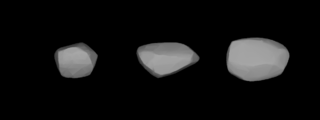
170 Maria is a Main belt asteroid that was discovered by French astronomer Henri Joseph Perrotin on January 10, 1877. Its orbit was computed by Antonio Abetti, and the asteroid was named after his sister, Maria. This is the namesake of the Maria asteroid family; one of the first asteroid families to be identified by Japanese astronomer Kiyotsugu Hirayama in 1918.

176 Iduna is a large main-belt asteroid that was discovered by German-American astronomer Christian Heinrich Friedrich Peters on October 14, 1877, in Clinton, New York. It is named after Sällskapet Idun, a club in Stockholm that hosted an astronomical conference; Idun is also a Norse goddess. A G-type asteroid, it has a composition similar to that of the largest main-belt asteroid, 1 Ceres.

191 Kolga is a large, dark main-belt asteroid that was discovered by German-American astronomer C. H. F. Peters on September 30, 1878, in Clinton, New York. It is named after Kólga, the daughter of Ægir in Norse mythology.

193 Ambrosia is a main belt asteroid that was discovered by the Corsican-born French astronomer J. Coggia on February 28, 1879, and named after Ambrosia, the food of the gods in Greek mythology.

273 Atropos is a typical Main belt asteroid that was discovered by Austrian astronomer Johann Palisa on 8 March 1888 in Vienna.
568 Cheruskia is a minor planet, specifically an asteroid orbiting in the asteroid belt that was discovered by German astronomer Paul Götz on 26 July 1905 from Heidelberg.

573 Recha is a minor planet, specifically an asteroid orbiting in the asteroid belt between Mars and Jupiter. The asteroid, discovered by German astronomer Max Wolf on September 19, 1905, was named after a character in Gotthold Ephraim Lessing's play Nathan the Wise and may have been inspired by the asteroid's provisional designation 1905 RC.
575 Renate is a minor planet, specifically an asteroid orbiting in the asteroid belt which was discovered by German astronomer Max Wolf on September 19, 1905. The name may have been inspired by the asteroid's provisional designation 1905 RE.

572 Rebekka is a minor planet orbiting the Sun, which was discovered on September 19, 1905, by a German astronomer Paul Götz in Heidelberg. It was named after a young lady from Heidelberg, and may have been inspired by the asteroid's provisional designation 1905 RB.
585 Bilkis is a minor planet, specifically an asteroid orbiting in the asteroid belt. It was discovered by German astronomer August Kopff in 1906 February and was given the Koran name for the Queen of Sheba. Photometric observations at the Palmer Divide Observatory in Colorado Springs, Colorado in 2006–7 were used to build a light curve for this object. The asteroid displayed a rotation period of 8.5742 ± 0.0005 hours and a brightness variation of 0.40 ± 0.02 in magnitude.
607 Jenny is a minor planet, specifically an asteroid orbiting in the asteroid belt that was discovered by German astronomer August Kopff on September 18, 1906.
620 Drakonia is a minor planet, specifically an asteroid orbiting in the asteroid belt. It was discovered October 26, 1906, in Taunton, Massachusetts, by American astronomer Joel Hastings Metcalf and given the preliminary designation 1906 WE. It may have been named for Drake University.
639 Latona is a minor planet, specifically an asteroid orbiting in the asteroid belt. It was discovered by German astronomer Karl Lohnert on July 19, 1907, at Heidelberg.
687 Tinette is a minor planet, specifically an asteroid orbiting primarily in the asteroid belt. It was discovered by Austrian astronomer Johann Palisa on 16 August 1909 from Vienna and was given the preliminary designation 1909 HG.

708 Raphaela is a minor planet orbiting the Sun.
840 Zenobia is a minor planet orbiting the Sun. It was discovered by German astronomer Max Wolf at Heidelberg on September 25, 1916. The origin of the name is uncertain, but it may be named after the Slavic god of the hunt.
947 Monterosa is a minor planet orbiting the Sun.
999 Zachia is a main-belt asteroid that was discovered by German astronomer Karl W. Reinmuth in 1923 and named after Hungarian astronomer Franz Xaver von Zach.
7816 Hanoi, provisional designation 1987 YA, is an eccentric stony asteroid and Mars-crosser from the inner regions of the asteroid belt, approximately 3 kilometers in diameter. It was discovered on 18 December 1987, by Japanese astronomer Masahiro Koishikawa at the Ayashi Station of the Sendai Astronomical Observatory, Japan, and later named after the Vietnamese capital of Hanoi.
9069 Hovland, provisional designation 1993 OV, is a stony binary Hungaria asteroid from the inner regions of the asteroid belt, approximately 3 kilometers in diameter.








